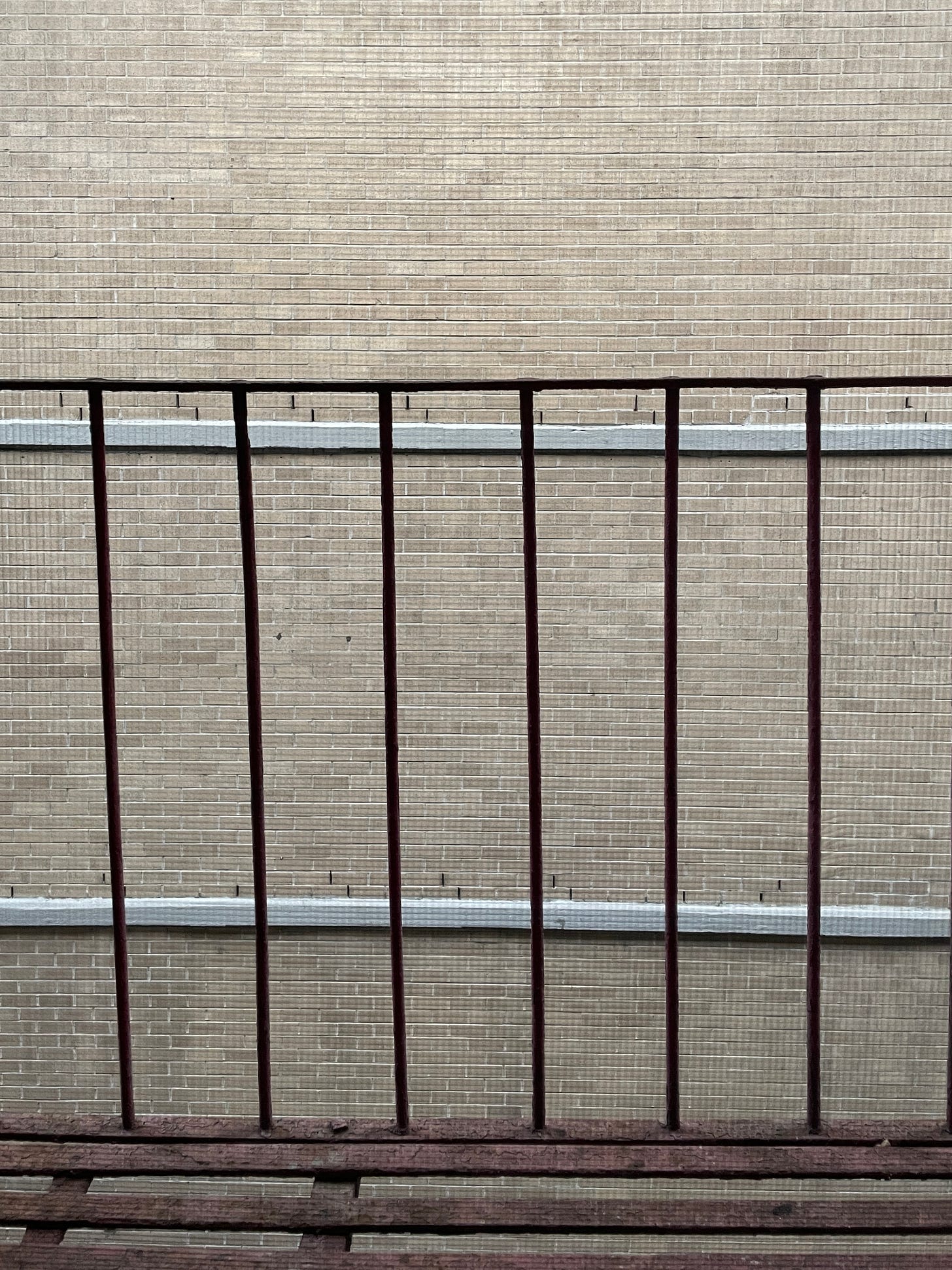Noel Arnaud’s line: ‘Je suis l’espace ou je suis’ (I am the space where I am) holds me captive as I stare at a brick wall.
After reading The Poetics of Space by Gaston Bachelard, I started to look at everything with a metaphysical eye. A brick wall becomes a galaxy, a nest turns into the leftover roots of a tree, and chipped paint becomes a fort for the third-floor ants. According to Bachelard, “when we dream, we are phenomenologists without realizing it.” I am learning to stay present through tenacious observations disguised as daydreams.
I am lucky enough to have a fire escape—even in its corroded state, fraught with occasional pigeon shit, broken pieces of plaster, and unstable metal planks. Though it isn’t red enough to confront its namesake, it is red enough to make New York City tourists swoon.
One spring evening, I entertained a private moment to clear my head. This required carving out a corner of space that did not yet exist in my usual prescriptions of perception.
It’s crazy how much of the world opens up to you when you peek at unusual corners.
Maybe because I have been staring at the brick building for nearly two years. The longer I stare at it, the more expansive it becomes—a cardinal view. The bricks are painted in a cosmic latte, which is the average shade of galaxies in the universe. An ordinary beige color. Neither formidable nor inspiring.
The brick wall offers some affinity, though it does not offer a skyline or windows to escape into. Because of this, I rely less on my outward gaze and more on my peripheral vision. I look inside the literal corners of my eyes, deep enough to feel the nerves of my vision.
Past the cosmic brick wall, I peek to the right.
The Manhattan Storage Unit is outlined in lowercase Helvetica, bold. A dissolving, one-way street becomes the birthplace of traffic. When I look up, the clouds move slowly between the lips of several buildings. Below my right, there is a backyard with string lights floating from one fence’s edge to the other, shaping a triangle. It signaled springtime. At the top, I see buildings with small glass windows: tinted, open, closed. They’re refracted by the silver rays of sunlight that come through the shrinking alleys. Finally, stretching a few stories high, I see a young honey locust tree. Mourning doves, pigeons, and shorebirds come and go. Some mount on small balconies from the building across, while others make a landing on my side of the fire escape.
Behind me, I make eye contact with a dove. She’s made a nest—a dainty but reliable one—wedged inside my AC unit. We stare at each other for minutes. When I turn away, I know she’s still looking.
Privacy does not exist anywhere, especially in New York.
I’m adamant it doesn’t, because something is always watching, either actively or passively. I like to imagine that when I’m tucked away in the corners of my imagination, I’m being watched passively: by the doves, by the bark of the trees, the ants hiking a trail in line across the white ledge. Only a fool would believe the world might lend a private moment exclusively for them, as if we do not exist as giants among miniatures. Miniatures among other giants.
We are in a constant state of witness, by the Earth itself, and by its network of unseen systems that connect us to the corners we can readily perceive and the ones we haven’t yet entered.
Watching the dove behind my AC unit, I couldn’t help but laugh. I remembered a Reddit thread my friend told me about weeks ago, claiming doves are the laziest nest makers. The comments were full of photos, an infinite scroll of doves perched on two or three crooked twigs, trying to make a nest out of seemingly nothing.
In his aptly titled section, Nests, Bachelard writes:
“And so when we examine a nest, we place ourselves at the origin of confidence in the world, we receive a beginning of confidence, an urge toward cosmic confidence. Would a bird build its nest if it did not have its instinct for confidence in the world?”
No, it wouldn’t, I say to myself. The dove knows it’s built a nest, undisturbed by how grand it is compared to that of a robin somewhere far away from here. Because here, in this corner, with me as its only witness, the nest is as good as it needs to be. Maybe that’s why we keep finding each other’s eyes.
Blue rimmed, black holes gape back at me. I know that I am in her corner, as much as she is in mine.
And I wonder what she thinks of my nest, my world—the 400 sq nest sucking my savings dry every minute that passes us by.
Maybe knowing we are meant to be seen is part of how we build confidence in the world. When we think we are alone, the world watches us. And when we watch the world, sometimes out of love, out of boredom, or spite, it watches back.








Great insights for a great book. It's very dense with lots of intriguing ideas; am interested in your thoughts on what constitutes a "home".